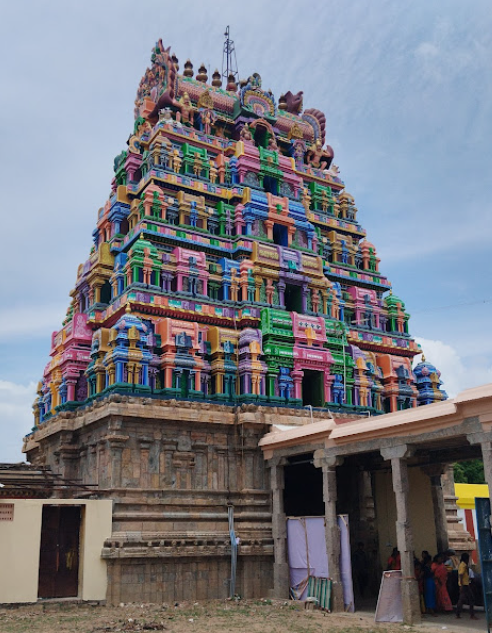Yama, the God of Death, felt a deep sadness about his role in taking lives, especially when there were many joyous tasks available. Troubled by this, he travelled to Thiruvarur to express his sorrow to Lord Shiva. In response, Lord Shiva instructed Yama to go to Sri Vanchiam and pray there. Following this guidance, Yama performed penance at the site.
Pleased with his devotion, Lord Vanchinadheswarar appeared before Yama on the day of Bharani Star in the month of Masi (February-March) and asked him what he wished. Yama expressed his concerns about being blamed for death, which caused him to suffer from Brahmmahati dosha, a curse associated with his duties. Lord Shiva reassured him that people would soon attribute death to causes such as disease, age, and accidents, rather than blaming him directly. He instructed Yama to permit only those with fewer sins to pass on, ensuring they would not be reborn, and emphasised that their end should be peaceful. Furthermore, he granted Yama the status of Kshetra Palaka, stating that devotees should first worship Yama before offering prayers at the Lord’s shrine. Consequently, the first puja in this temple each day is dedicated to Yama.
Sthala Puranam :
Visiting Sri Vanchiyam is believed to be destined by the grace of the Lord. Personally, I can attest to this, as I had attempted to visit the temple three or four times without success; my eventual visit was completely unplanned.
The legend begins with a conflict between Sridevi (Lakshmi) and Bhoomadevi, leading Sridevi to leave Vaikuntam. In his yearning to reunite with Sridevi, Lord Vishnu undertook penance at this site, which led to the name "SriVanchiyam" (meaning "wish"). Nearby, there exists a Varadaraja Perumal temple; visiting SriVanchiyam is considered incomplete without also visiting this temple.
This temple is unique, as it highlights the significance of Yama (the God of Death) alongside Lord Shiva. Upon entering the temple, devotees encounter shrines for Yama and Chitragupta situated on the left side of the temple premises, known as the Agni Moolai.
Yama, burdened with Brahmahathi dosham due to his role in death, felt distressed by the blame he received for the deaths of humans. Seeking relief, he prayed to Lord Thyagarajar at Tiruvarur and was advised to go to SriVanchiyam for penance. After his devoted prayers, Lord Shiva appeared before him, absolving him of the blame for death and allowing people to attribute passing to illness or accidents instead. Shiva assured Yama that only those with good deeds would be able to visit this temple and granted him the role of the town's guardian. Consequently, it is said that the fear of death is alleviated for devotees who worship here. Devotees commonly offer payasam made from cow and buffalo milk to Yama and Chitragupta.
The order of worship at this temple is specific. Devotees must first pay homage to Yama and Chitragupta in their dedicated shrine before taking a dip at the Gupta Gangai Theertham. Only after these rituals can they proceed to the main temple. Signage at the temple entrance outlines this order clearly.
A unique belief states that if a person passes away in Srivanchiyam, Lord Shiva himself whispers the panchaksharam (five-letter mantra) into their ears, granting them immunity from Yama's judgement.
The Ganga river once sought Lord Shiva's help to rid herself of the sins accumulated from those bathing in her waters. He advised her to come to Sri Vanchiyam, a site that had already purified Yama of his sins. Following this guidance, Ganga relinquished 999 parts of her powers here, retaining only one in Kasi. Thus, the Teertham is known as Gupta Gangai (Hidden Ganga) and bathing in it is deemed equivalent, if not superior, to bathing in Kasi. Sri Vanchiyam is among six sacred places that are said to hold the same significance as Kasi.
The Teertham created by Lord Shiva is believed to have existed across all four yugas, referred to variously as Punya Teertham, Atri Teertham, Parasara Teertham, and Muni Teertham.
The Sun God, Suryan, lost his brightness after being punished by Veerabhadra for participating in Daksha’s yagna. To regain his power, he undertook a month-long penance at Gupta Gangai, after which Lord Shiva restored his luminosity.
Interestingly, the temple does not have a separate shrine for Ambal/Durga, as she is worshipped as part of Mahishasuramardhini. Both Yama and Bhairavar are depicted in meditative states, stripped of their weapons, emphasising that they are powerless in the presence of the all-powerful Lord Shiva.
In addition to the hymns composed by Sambandar, Appar and Sundarar also paid their respects to Lord Shiva at this temple.
Notably, the temple features several unique shrines, including those for the Pancha Bootha Lingas and Jyeshta Devi (Moodevi). The original structure of the temple dates back to the Chola period, with inscriptions from Chola, Pandya, and Nayak times. One of these inscriptions refers to the site as Raja Gambheera Chaturvedi Mangalam.
Administration History :
The temple was originally built before the 7th century, with significant reconstructions during the Chozha period, particularly under Rajaraja I. Further extensions were made during the Vijayanagara Nayakas period. Later, the Nattukottai Nagarathars maintained the temple. Currently, it is under the administration of the Hindu Religious and Charitable Endowments Department.
